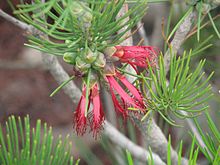Calothamnus
The petals are small and fall off the flower soon after it opens but the stamens are long, numerous and usually bright red.
The flowers are in small groups or dense spikes on leafless, older stems or between the leaves on younger ones.
The sepals are fused to form a bell-shaped cup which is often immersed in the branch and there are four or five petals which usually fall off after the flower has opened.
It was first formally described in 1806 by the French biologist Jacques Labillardière in Novae Hollandiae Plantarum Specimen, Volume 2.
[7]: 174 [8] In 2014, Lyndley Craven and others proposed, mainly on the basis of DNA evidence, that species in the genus Calothamnus, along with those in Beaufortia, Conothamnus, Eremaea, Lamarchea, Petraeomyrtus, Phymatocarpus and Regelia be transferred to Melaleuca.

